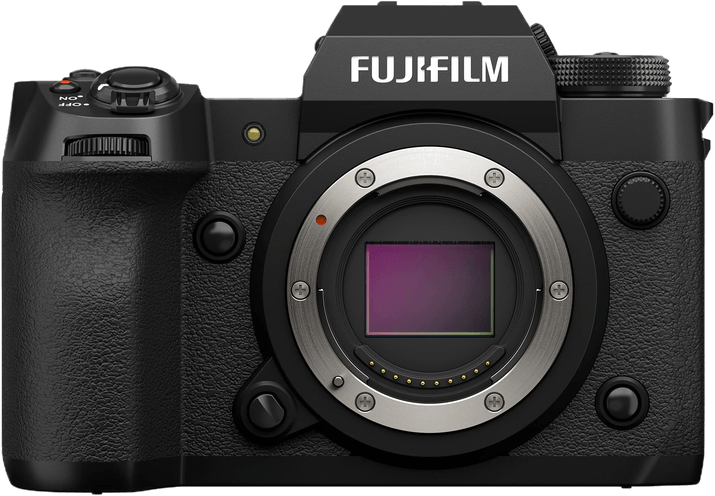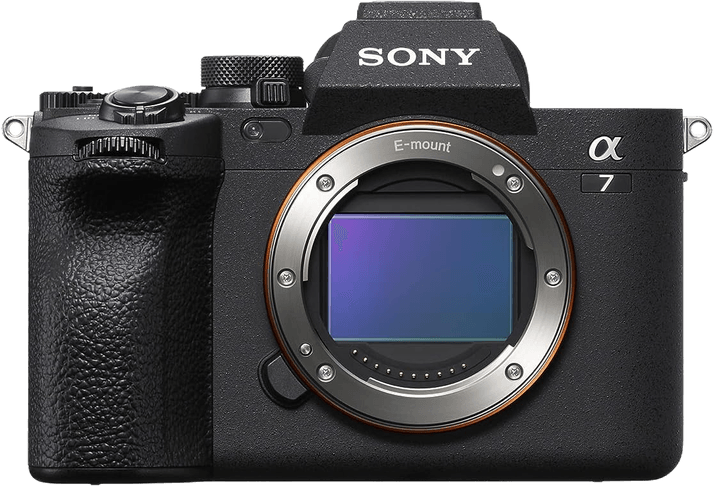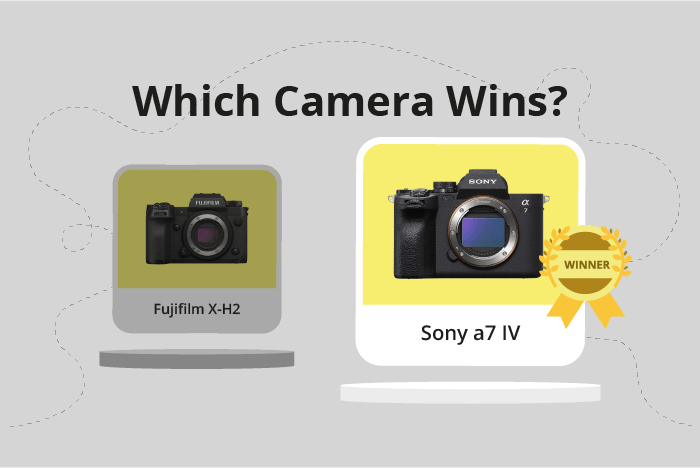Fujifilm X-H2 vs Sony a7 IV Comparison
Fujifilm X-H2

Sony a7 IV

The Sony a7 IV edges out the Fujifilm X-H2 with a score of 84/100 compared to 82/100. Both cameras are mirrorless and share similar dimensions and weight, with the Sony a7 IV being slightly more compact and lighter. The Fujifilm X-H2 was announced in 2022, while the Sony a7 IV was released in 2021.
The Sony a7 IV’s higher score indicates better overall performance, but it comes at a higher launch price of $2499 compared to the Fujifilm X-H2’s $1999. The Fujifilm X-H2, although scoring slightly lower, offers a more budget-friendly option without compromising too much on quality.
While both cameras have their advantages, the Sony a7 IV proves to be a better choice for those willing to invest in a higher-priced option. On the other hand, the Fujifilm X-H2 is a great alternative for budget-conscious photographers who still want excellent performance.
Fujifilm X-H2 vs Sony a7 IV Overview and Optics
The Sony a7 IV outperforms the Fujifilm X-H2 in optics, scoring 85/100 compared to the X-H2’s 81/100. Both cameras share some common specifications, including a CMOS sensor, image stabilization, and compatibility with their respective lens mounts (Sony FE for the a7 IV and Fujifilm X for the X-H2).
The Sony a7 IV excels with its full-frame sensor, which provides better low-light performance and increased dynamic range than the Fujifilm X-H2’s APS-C sensor. Additionally, the a7 IV’s DXOMARK sensor score of 97 indicates superior image quality. Despite having fewer megapixels (33) compared to the X-H2 (40), the a7 IV’s full-frame sensor compensates for this difference, resulting in higher overall image quality.
On the other hand, the Fujifilm X-H2 has a higher shooting speed of 15 frames per second, compared to the a7 IV’s 10 frames per second. This advantage makes the X-H2 more suitable for action and sports photography. Furthermore, the X-H2’s 40-megapixel sensor allows for more detailed images, which may be beneficial for certain applications, such as landscape or product photography.
In terms of optics, the Sony a7 IV is the superior choice due to its full-frame sensor and higher DXOMARK score, which contribute to better overall image quality. The Fujifilm X-H2, while not as strong in this area, still offers advantages in shooting speed and megapixels, making it a suitable option for specific photography needs. Ultimately, the choice between these two cameras depends on the photographer’s priorities and preferred shooting scenarios.
Fujifilm X-H2 vs Sony a7 IV Video Performance
The Fujifilm X-H2 outperforms the Sony a7 IV in video capabilities. Both cameras share some common specifications, such as video dimensions of 3840 x 2160 and built-in time-lapse functionality, making them suitable for creative videography projects.
The Fujifilm X-H2’s superior video performance stems from its higher maximum resolution of 8K and video frame rate of 360fps, more than double that of the Sony a7 IV. This allows the X-H2 to capture smoother slow-motion footage, providing greater flexibility in post-production and enhancing the final video quality. The higher frame rate is a significant advantage for videographers who prioritize capturing fast-paced action or detailed movement.
Fujifilm X-H2 vs Sony a7 IV Features and Benefits
The Fujifilm X-H2 edges out the Sony a7 IV with a feature score of 85/100 compared to 83/100. Both cameras share several similarities, including a 3-inch screen, touchscreen capability, flip screen, GPS absence, and the presence of WIFI and Bluetooth connectivity.
The Fujifilm X-H2 stands out with a higher screen resolution of 1,620,000 dots, providing a sharper and more detailed display for composing and reviewing images. This advantage allows photographers to better assess their shots and make necessary adjustments, improving the overall shooting experience.
On the other hand, the Sony a7 IV has its strengths, but in this comparison of features, it does not surpass the Fujifilm X-H2. Both cameras are evenly matched in most aspects, making the higher screen resolution of the X-H2 the primary differentiator.
Given these points, the Fujifilm X-H2 emerges as the winner in this comparison, offering a superior screen resolution that enhances the user experience. The Sony a7 IV remains a strong contender, matching the X-H2 in many areas, but falling short in screen resolution. Ultimately, photographers seeking a camera with a more detailed display should opt for the Fujifilm X-H2, while those who prioritize other aspects may still find the Sony a7 IV to be a suitable choice.
Fujifilm X-H2 vs Sony a7 IV Storage and Battery
The Fujifilm X-H2 wins in the storage and battery category with a score of 79/100, while the Sony a7 IV scores 76/100. Both cameras have two memory card slots and support USB charging. The X-H2 accepts CFexpress Type B and SD (UHS-II compatible) cards, while the a7 IV takes CFexpress Type A and SD (UHS-II compatible) cards.
The X-H2 outperforms the a7 IV in battery life, providing 680 shots per charge with its NP-W235 battery, compared to the a7 IV’s 580 shots using the NP-FZ100 battery. This longer battery life makes the X-H2 more suitable for extended shooting sessions.
The a7 IV, however, uses CFexpress Type A cards, which are smaller and lighter than Type B cards. This can be an advantage for photographers prioritizing compactness and weight reduction in their gear.
Considering these factors, the Fujifilm X-H2 is the better choice for those who need a longer battery life and are comfortable with the larger CFexpress Type B cards. The Sony a7 IV may be preferable for those seeking a more compact storage solution with its use of CFexpress Type A cards.
Alternatives to the Fujifilm X-H2 and Sony a7 IV
Are you still undecided about which camera is right for you? Have a look at these popular comparisons that feature the Fujifilm X-H2 or the Sony a7 IV:

